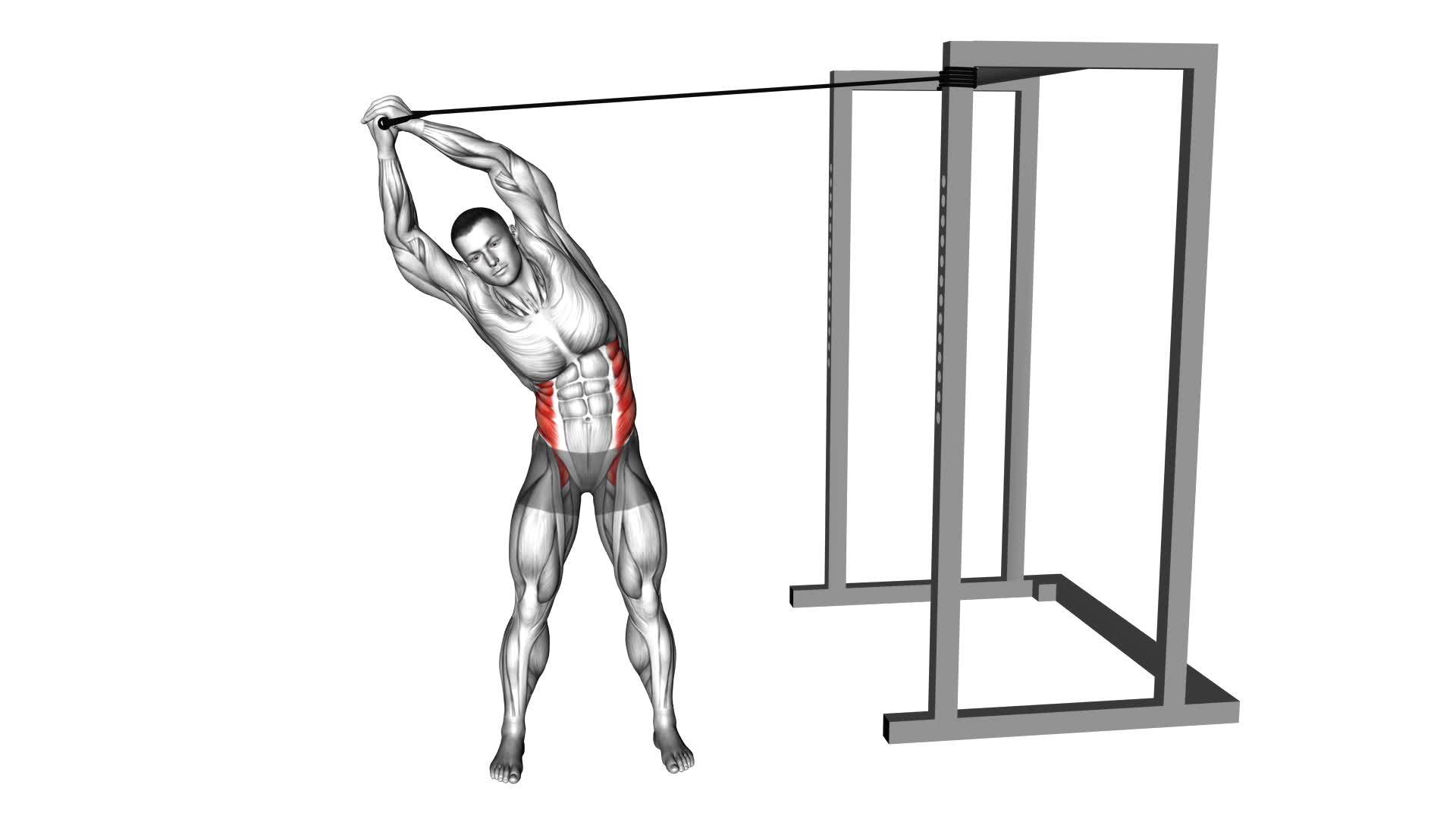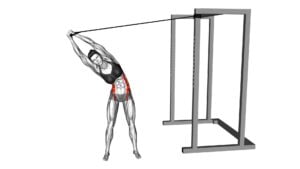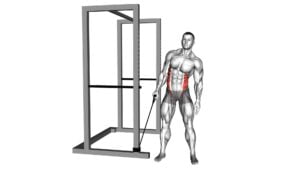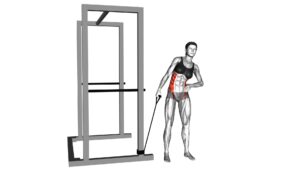Band Overhead Side Bend (male) – Video Exercise Guide & Tips

Looking to strengthen your core and improve flexibility? Check out this video exercise guide for the Band Overhead Side Bend.
Watch This Exercise Video
In just a few minutes, you'll learn how to properly perform this exercise, along with tips to avoid common mistakes.
With the help of a resistance band, you can increase the intensity and challenge your muscles even more.
Get ready to feel the burn and achieve your fitness goals with this effective workout.
Key Takeaways
- The band overhead side bend targets the obliques and engages the entire core.
- Using a resistance band increases the intensity of the exercise and allows for variations to target different muscle groups.
- Proper form is important to avoid common mistakes such as overarching the back and using too much resistance.
- To increase the intensity, gradually increase the tension of the resistance band and incorporate variations of the exercise.
Benefits of the Band Overhead Side Bend
You can experience multiple benefits by incorporating the Band Overhead Side Bend into your workout routine. This exercise primarily targets the obliques, but it also engages the entire core, including the rectus abdominis and transverse abdominis. By using a resistance band, you can add intensity and challenge to your side-bending movements.
One of the key benefits of the Band Overhead Side Bend is improved core strength and stability. As you perform the exercise, your core muscles work hard to maintain control and balance, resulting in a stronger and more stable midsection. This can enhance your overall athletic performance and help prevent injuries.
In addition to core strength, this exercise also helps to improve flexibility in the side body. The controlled bending motion stretches the muscles along the sides of your torso, promoting greater range of motion and flexibility. This can be particularly beneficial for activities that require twisting or reaching motions, such as golf, tennis, or even everyday tasks like reaching for items on high shelves.
There are also variations of the Band Overhead Side Bend that you can incorporate into your routine to target different muscle groups. For example, you can perform the exercise with a single arm, focusing on one side at a time. This variation allows for greater isolation and can help to correct any muscle imbalances.
Equipment Needed for the Exercise
To perform the Band Overhead Side Bend exercise, you'll need a resistance band. The resistance band is a versatile and portable piece of equipment that can be easily incorporated into your workout routine. It provides resistance to help strengthen and tone your muscles.
When choosing a resistance band, make sure to select one that suits your fitness level and goals. Resistance bands come in different colors, which indicate their level of resistance.
The proper technique for the Band Overhead Side Bend exercise involves standing with your feet shoulder-width apart and holding one end of the resistance band in each hand. Raise your arms overhead, keeping a slight bend in your elbows. Engage your core and slowly lean to one side, feeling a stretch along the opposite side of your body. Return to the starting position and repeat on the other side.
Remember to maintain proper form throughout the exercise and avoid any jerking or swinging motions. By using different variations of the Band Overhead Side Bend exercise, you can target different muscle groups and add variety to your workout routine.
Step-By-Step Instructions for Proper Form
To perform the Band Overhead Side Bend exercise with proper form, follow these step-by-step instructions.
- First, secure a resistance band overhead by attaching it to a sturdy anchor point.
- Stand with your feet shoulder-width apart and hold one end of the band in each hand, above your head.
- Keep your arms straight and your core engaged throughout the exercise.
- Next, slowly bend your torso to the side, towards the direction of the band, while keeping your arms extended overhead.
- Make sure to maintain a straight posture and avoid leaning forward or backward.
- Pause for a moment at the bottom of the movement, feeling the stretch in your oblique muscles.
- Return to the starting position by slowly straightening your torso, using your obliques to control the movement.
- Repeat on the opposite side.
The Band Overhead Side Bend exercise targets the oblique muscles, helping to strengthen and tone your sides. It also improves core stability and enhances overall posture.
Common Mistakes to Avoid During the Exercise
To ensure that you perform the band overhead side bend exercise correctly and avoid common mistakes, it's important to be aware of the potential dangers of incorrect form and overusing resistance bands.
Incorrect form can put unnecessary strain on your muscles and lead to injury, while overusing resistance bands can cause muscle imbalances and hinder your progress.
Incorrect Form Dangers
Avoiding incorrect form dangers is crucial when performing the Band Overhead Side Bend exercise. To ensure injury prevention and proper technique, be mindful of the following:
- Overarching your back: Avoid excessive arching of your lower back, as it can strain the muscles and potentially lead to injury.
- Using too much resistance: Start with a lighter resistance band and gradually increase the resistance as your strength improves. Using too much resistance can put unnecessary strain on your muscles and joints.
- Neglecting proper alignment: Maintain proper alignment throughout the exercise by keeping your spine straight and shoulders relaxed. Poor alignment can increase the risk of injury.
- Rushing through the movement: Take your time and focus on performing the exercise with control. Avoid rushing through the movement, as it can compromise your form and increase the likelihood of injury.
Overusing Resistance Bands
When using resistance bands for the Band Overhead Side Bend exercise, it's important to avoid overusing them to prevent strain and potential injury. Overtraining risks can arise when you push your body too hard without giving it enough time to recover. It's crucial to listen to your body and give it the rest it needs.
Additionally, proper band selection is essential to prevent overuse injuries. Using a band that's too heavy or too light can lead to imbalances and strain on your muscles and joints. Choose a band that provides enough resistance to challenge you without compromising your form.
Tips for Increasing the Intensity of the Exercise
To increase the intensity of the Band Overhead Side Bend exercise, incorporate resistance bands of higher tension. This will provide more resistance and challenge your muscles to work harder. Here are four tips to help you increase the difficulty and get the most out of this exercise:
- Gradually increase the tension: Start with a resistance band that feels challenging but manageable. As you get stronger, gradually increase the tension by using bands with higher resistance. This will keep pushing your muscles and ensure continuous progress.
- Focus on proper form: Maintaining proper form is crucial for maximizing the effectiveness of this exercise. Keep your core engaged, maintain a slight bend in your knees, and avoid arching your back. This will help target the right muscles and prevent injury.
- Add a pause at the bottom: When you reach the bottom of the side bend, hold the position for a few seconds before returning to the starting position. This will increase the time under tension and intensify the workout for your obliques.
- Incorporate proper breathing technique: Exhale as you bend to the side and inhale as you return to the starting position. This helps engage your core muscles and promotes better stabilization.
Alternative Variations of the Band Overhead Side Bend
Try incorporating different variations of the Band Overhead Side Bend exercise to target your obliques in new and challenging ways. One alternative variation you can try is the resistance band modification. Instead of using just your body weight, attach a resistance band to a stable anchor point and hold the other end with your hand. As you perform the side bend, the resistance from the band will provide an additional challenge to your obliques, helping to strengthen and tone them even more effectively.
Another variation to consider is focusing on your breathing technique. As you perform the exercise, make sure to inhale deeply through your nose and exhale fully through your mouth. This proper breathing technique helps to engage your core muscles and activate your obliques even more effectively. By paying attention to your breath, you can enhance the intensity and effectiveness of the Band Overhead Side Bend exercise.
Incorporating these alternative variations into your workout routine can help keep your oblique muscles engaged and prevent plateauing. Remember to start with lighter resistance bands and gradually increase the tension as you become more comfortable and stronger. Always listen to your body and stop any exercise if you feel pain or discomfort.
Stay consistent and keep challenging yourself to achieve the best results.
Frequently Asked Questions
How Many Repetitions and Sets Should I Do for the Band Overhead Side Bend Exercise?
To maximize the benefits of the band overhead side bend exercise, focus on proper form. Start by performing 2-3 sets of 10-12 repetitions on each side. This will help strengthen your obliques and improve your core stability.
Remember to maintain a neutral spine, engage your core, and breathe throughout the movement.
As you progress, you can increase the number of sets or repetitions to challenge your muscles further.
Can I Perform the Band Overhead Side Bend Exercise if I Have a Shoulder or Back Injury?
If you have a shoulder or back injury, it may not be safe to perform the band overhead side bend exercise. It's important to prioritize your health and avoid exercises that could worsen your condition.
Instead, consider modifying the exercise or opting for alternative exercises that target the same muscle groups without putting strain on your injured areas.
Always consult with a medical professional or a certified trainer for personalized advice and guidance.
Is It Better to Use a Resistance Band or Dumbbells for the Band Overhead Side Bend Exercise?
When deciding between a resistance band and dumbbells for the band overhead side bend exercise, consider the benefits of using resistance bands. They provide constant tension throughout the movement, engaging your muscles more effectively. Plus, resistance bands are portable and versatile, allowing you to easily adjust the intensity.
Dumbbells, on the other hand, offer a fixed weight. Ultimately, the choice depends on your preference and fitness goals.
How Long Should I Hold the Stretch at the Bottom of the Movement During the Band Overhead Side Bend Exercise?
To properly perform the band overhead side bend exercise, it's important to know how long to hold the stretch at the bottom of the movement. When doing this exercise, aim to hold the stretch for about 2-3 seconds before returning to the starting position.
This will help to engage the targeted muscles effectively and prevent any unnecessary strain or injury. Remember to avoid common mistakes such as using too much resistance or hunching your shoulders during the movement.
Can the Band Overhead Side Bend Exercise Help to Improve My Posture?
The band overhead side bend exercise can definitely help improve your posture. By incorporating this exercise into your workout routine, you'll strengthen and stretch the muscles in your core, back, and shoulders, which are key for maintaining proper posture.
To get the most out of this exercise, make sure to maintain good form and technique. Keep your core engaged, shoulders down and back, and focus on the side bending motion.
Conclusion
In conclusion, the band overhead side bend is a beneficial exercise that targets the oblique muscles and improves core stability. It requires minimal equipment and can be easily incorporated into a workout routine.
By following the proper form and avoiding common mistakes, individuals can maximize the effectiveness of this exercise.
Additionally, increasing the intensity and exploring alternative variations can provide additional challenges and help individuals progress in their fitness journey.

Author
Years ago, the spark of my life’s passion ignited in my mind the moment I stepped into the local gym for the first time. The inaugural bead of perspiration, the initial endeavor, the very first surge of endorphins, and a sense of pride that washed over me post-workout marked the beginning of my deep-seated interest in strength sports, fitness, and sports nutrition. This very curiosity blossomed rapidly into a profound fascination, propelling me to earn a Master’s degree in Physical Education from the Academy of Physical Education in Krakow, followed by a Sports Manager diploma from the Jagiellonian University. My journey of growth led me to gain more specialized qualifications, such as being a certified personal trainer with a focus on sports dietetics, a lifeguard, and an instructor for wellness and corrective gymnastics. Theoretical knowledge paired seamlessly with practical experience, reinforcing my belief that the transformation of individuals under my guidance was also a reflection of my personal growth. This belief holds true even today. Each day, I strive to push the boundaries and explore new realms. These realms gently elevate me to greater heights. The unique combination of passion for my field and the continuous quest for growth fuels my drive to break new ground.



